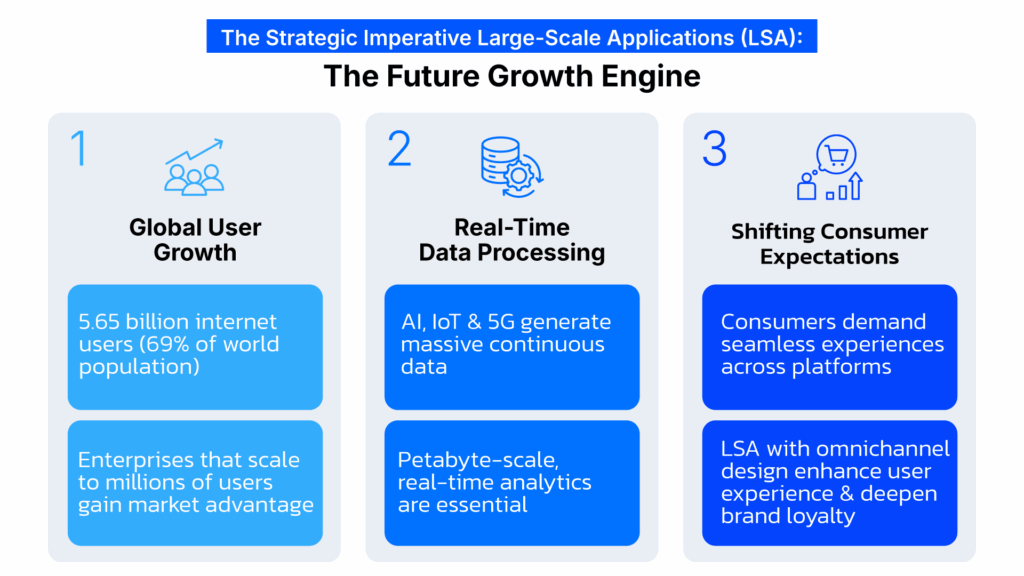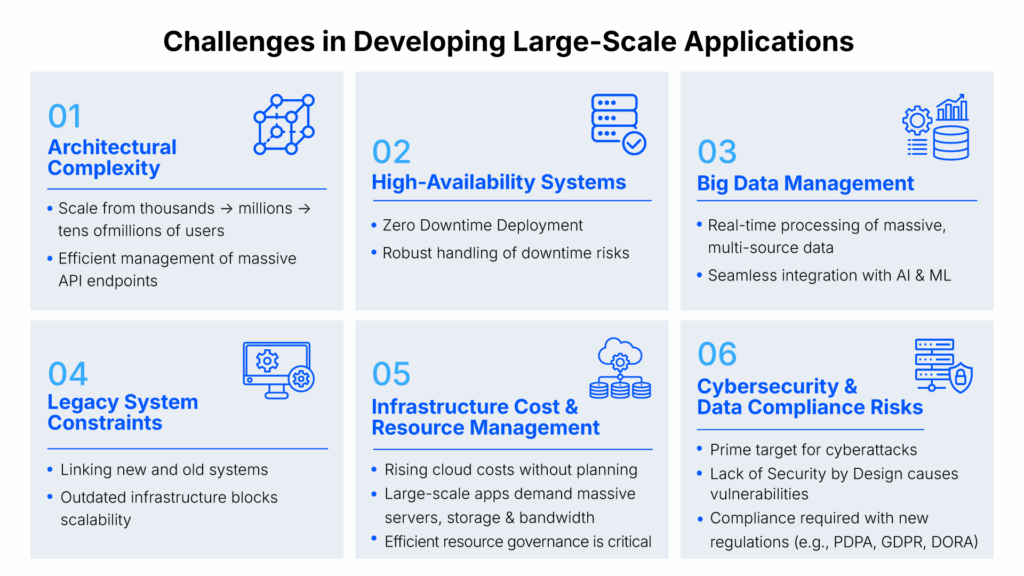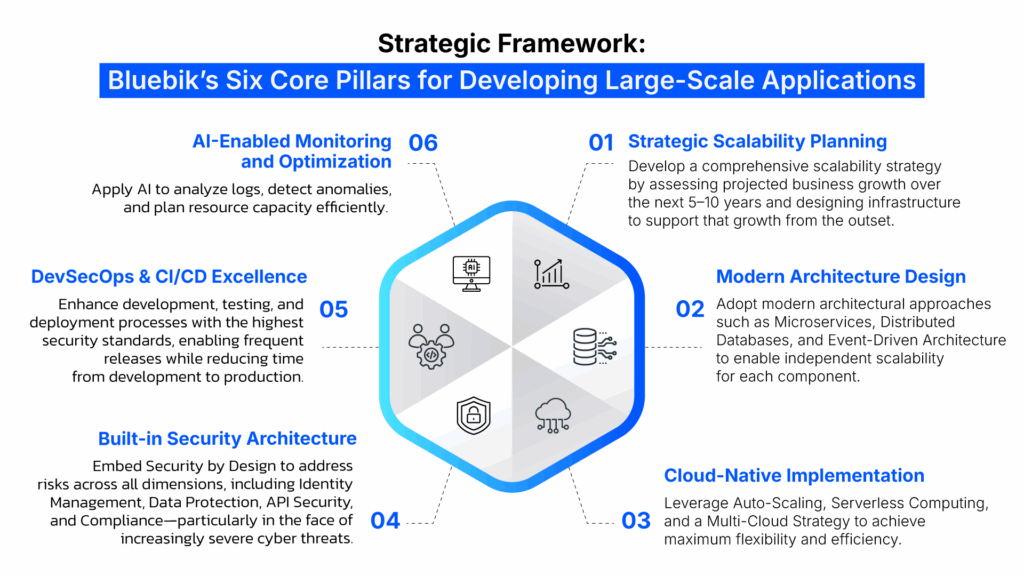
Executive Overview
Thailand’s enterprises face a defining moment: evolve through Large-Scale Applications or risk competitive obsolescence. Legacy IT systems and outdated organizational structures can no longer support the velocity and scale demands of Thailand’s hyperconnected, rapidly evolving marketplace. As Thailand transitions into the Digital Economy era, competitive advantage is determined by the ability to operate, adapt, and scale in real time.
Thailand’s digital payment infrastructure demonstrates this transformation’s momentum—144 million active banking accounts generated over 6.28 billion transactions in just ten months of 2023, according to the Bank of Thailand. Internet Banking and Mobile Banking have emerged as the dominant e-payment channels, signaling that digital transformation is no longer optional but a primary driver of business performance.
Technology investment is accelerating accordingly. Gartner forecasts Thai IT spending will reach THB 996 billion (~USD 29 billion) in 2025, representing a 7.9% year-on-year increase. This trajectory demands organizations move beyond reactive adaptation toward strategic reinvention—enabled by Large-Scale Applications.
Why Large-Scale Applications Are a Strategic Imperative
Large-Scale Applications go far beyond being technical infrastructure—they function as the strategic core of modern enterprises. Designed for resilience, scale, and real-time responsiveness, they enable organizations not only to keep pace with Thailand’s digital momentum but also to shape it. From powering high-volume banking platforms to orchestrating e-commerce ecosystems, Large-Scale Applications have become the silent growth engines that determine whether businesses can deliver at scale, compete effectively, and lead in the Digital Economy.
1. Seamless Omnichannel Experiences
Systems designed for true omnichannel integration enhance service efficiency, strengthen brand loyalty, and ensure consistent user experiences across all touchpoints—delivering sub-second response times regardless of channel or device.
2. Real-Time Big Data Processing
As data volumes reach petabyte scale, real-time processing enables faster, more accurate decision-making while supporting personalized, data-driven services that adapt to customer behavior instantaneously.
3. User Scalability as Competitive Advantage
Platforms that can stably support millions of users and massive datasets deliver a clear competitive edge—capturing market share ahead of rivals and positioning the business for sustained leadership.
Large-Scale Applications are not merely the next stage of IT evolution—they are the enterprise’s growth engine, the foundation of digital resilience, and the decisive factor separating industry leaders from followers in the Digital Economy.
Global and Local Disruptors Redefining Market Leadership

Global Disruptors Driving the Shift
The Global Digital User Growth
- By July 2024, 5.65 billion internet users (69% of the global population)
- Platforms must handle multi-million user loads with exceptional stability
- Enterprises able to deliver at this scale will capture and sustain market dominance
Exponential Data Growth and Real-Time Processing Demands
- AI, IoT, and 5G generate unprecedented data volumes
- Requires architectures built for petabyte-scale, real-time analytics
- Precision decision-making and operational agility separate leaders from laggards
Evolving Consumer Expectations
- Digital-native consumers demand seamless, integrated experiences
- Omnichannel Large-Scale Applications meet these expectations
- Consistent, superior service delivery deepens loyalty
Thailand’s Cashless Society: A Pivotal Economic Shift
These global disruptors are mirrored in Thailand’s rapid transition toward a cashless society, fundamentally reshaping its digital economy. Government-led digital policies are transforming spending behaviors and service consumption patterns across all demographic groups.
The Visa Consumer Payment Attitudes Study 2023 shows that over 80% of Thai consumers can live cash-free for an average of nine days, underscoring widespread adoption of digital payments.
Key Large-Scale Applications driving this transformation include:
- PromptPay — Processing 2.24 billion transactions valued at THB 4.59 trillion in May 2025 alone, showcasing the scale and velocity of Thailand’s digital payment ecosystem.
- Digital Wallet & NDID — The government’s first-phase digital wallet distributed THB 10,000 to 14.5 million recipients, while over 40 million Thais now rely on NDID for secure digital identity verification.
This surge in digital transactions presents both unprecedented opportunities and stark risks. For Thai enterprises, it is no longer just a wake-up call—it is a last-mover risk. Those still anchored in legacy systems will struggle to remain competitive in an economy where scale, speed, and trust are already being redefined.
Challenges in Developing Competitive Large-Scale Applications
While Large-Scale Applications promise significant strategic advantages, building them to deliver at scale is inherently complex and laden with risk. Achieving stable, adaptable platforms that can grow with the business requires meticulous planning and disciplined execution across multiple dimensions:

1. Architectural Complexity
- Scaling from thousands to millions—or even tens of millions—of users demands sophisticated architectures such as distributed systems, multi-region deployments, and data sharding to accelerate processing speed.
- The architecture must ensure seamless interoperability between components while efficiently managing a large number of API endpoints. This is critical for large-scale applications that integrate with banking, taxation, logistics, and other enterprise systems. The number of services should be optimized to align with the application’s scale and the team’s operational capacity, preventing unsustainable maintenance costs.
2. High-Availability Systems
- Even a few minutes of downtime can cause substantial financial losses.
- Zero-downtime deployment strategies, robust failover mechanisms, and automated 24/7 monitoring are essential to maintaining uninterrupted service and safeguarding brand trust.
3. Big Data Management
- The platform must be capable of processing massive volumes of data—real-time or near real-time—from multiple sources.
- It should also enable deep integration with AI and machine learning analytics to deliver predictive, actionable insights.
4. Legacy System Constraints
- Replacing legacy systems—often in use for over a decade—cannot be done in a single step. Phased approaches such as the Strangler Pattern and API wrappers allow gradual migration while preserving backward compatibility.
- Outdated infrastructure that cannot scale will inevitably become a barrier to growth, making it essential to have a well-defined modernization and migration roadmap, backed by effective risk management.
5. Infrastructure Resource and Cost Management
- Without rigorous planning from the outset, cloud and infrastructure costs can escalate three- to fivefold as workloads scale.
- Large-scale applications demand significant server, storage, and bandwidth capacity. Organizations must optimize resource allocation and reduce unnecessary requests to keep costs under control. Effective resource governance is fundamental to sustainable growth.
6. Cybersecurity and Regulatory Compliance
- Applications with large user bases or high-value data are prime targets for cybercriminals and require layered protection—spanning the application, network, and data layers.
- Failing to embed Security by Design from the outset can lead to data breaches, compliance failures, and lasting reputational damage.
- Regulations such as PDPA, GDPR, and the Digital Operational Resilience Act (DORA) are increasingly stringent and specifically govern large-scale systems, making compliance essential.
Ultimately, these risks and challenges require ongoing governance, disciplined operations, and the ability to build and sustain in-house expertise and skilled teams over time.
Strategic Framework: Bluebik’s Six Core Pillars for Developing Large-Scale Applications

Lessons from Global Leaders: Large-Scale Applications as a Game Changer

Worldwide, market leaders in technology, retail, and financial services demonstrate that Large-Scale Applications function as strategic assets capable of redefining customer experiences and reshaping entire industries. These organizations showcase how purposeful investment in architecture, scalability, and resilience translates directly into sustained market dominance.
| Company | Key Practice / Impact |
| Netflix | Employs Chaos Monkey to test system resilience and IT infrastructure, combined with a microservices architecture and chaos engineering, to deliver uninterrupted service to over 280 million users worldwide. |
| Central Retail | Integrates big data systems with cloud infrastructure to manage omni-channel customer experiences, serving millions of users seamlessly. |
| Kasikornbank | Modernized its core banking architecture to accommodate the rapid growth of digital customers. |
| SCB | Through NDID integration, customers can verify their identity via the SCB EASY app 24/7 and through other banking apps within one hour, significantly reducing the time required to open an account. |
| Optimized its Apache Kafka architecture to process more than 7 trillion messages per day (source: AltexSoft and ByteByteGo technical reports). |
These cases validate a fundamental principle: organizations treating Large-Scale Applications as strategic infrastructure—rather than merely software—position themselves to outpace competitors and adapt to future market demands. Whether serving hundreds of millions of global users or delivering mission-critical services to local markets, scalability, resilience, and adaptability remain the foundation of digital-era leadership.
Building Future-Ready Infrastructure
In the digital economy, competitiveness hinges on investing in systems that are flexible, capable of serving millions of users, processing massive volumes of data in real time, ensuring strong cybersecurity, and managing infrastructure costs effectively.
Bluebik stands ready to be your strategic partner in developing Large-Scale Applications that meet these requirements—offering end-to-end services across strategy, IT architecture, infrastructure, software development, cybersecurity, and cloud management to support sustainable growth in a constantly evolving digital world.
📩 Contact Bluebik today to unlock your organization’s full digital potential.
✉ [email protected] | ☎ +66 2 636 7011











![Thumbnail [Post Event] HOW](https://bluebik.com/wp-content/uploads/2025/12/Thumbnail-Post-Event-HOW.png)
